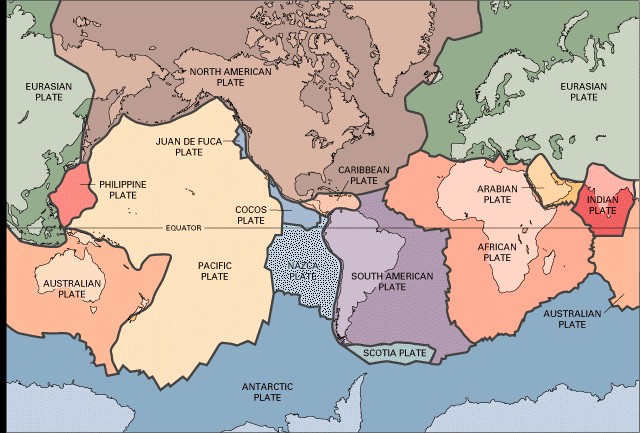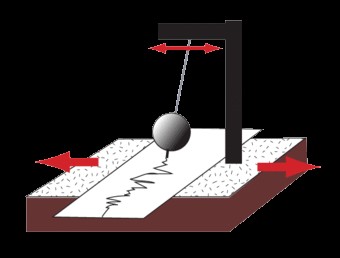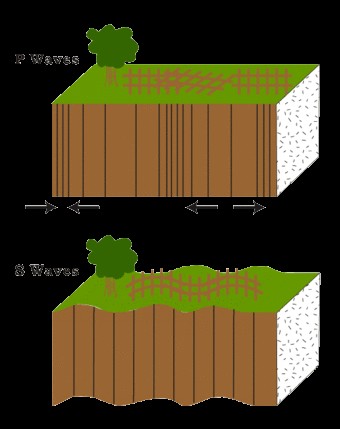Earthquake waves, also known as seismic waves, are vibrations that travel through the Earth as a result of earthquakes, volcanic eruptions, explosions, or even human activities. Understanding how these waves travel is crucial for seismologists and anyone interested in natural disasters. TRAVELS.EDU.VN offers expert insights and resources to help you learn more about seismic activity and how it affects our world. These waves are vital for understanding the Earth’s interior and predicting future seismic events. This article will cover seismic wave propagation, earthquake wave speed, and seismic wave behavior.
1. What are Earthquake Waves?
Earthquake waves, or seismic waves, are the energy released during an earthquake that travels through the Earth’s interior and along its surface. These waves provide valuable information about the Earth’s structure and the mechanics of earthquakes. Understanding these waves is essential for predicting potential seismic events and mitigating their impact.
1.1 Types of Seismic Waves
There are two main types of seismic waves: body waves and surface waves. Body waves travel through the Earth’s interior, while surface waves travel along the Earth’s surface. Each type has distinct characteristics and behaviors, which seismologists use to analyze earthquake events.
- Body Waves: Travel through the Earth’s interior.
- Surface Waves: Travel along the Earth’s surface.
1.2 Body Waves: P-waves and S-waves
Body waves are further divided into two types: Primary waves (P-waves) and Secondary waves (S-waves). P-waves are compressional waves, meaning they cause particles to move in the same direction as the wave’s propagation. S-waves are shear waves, causing particles to move perpendicular to the wave’s direction.
- P-waves (Primary Waves): Compressional waves that travel through solids, liquids, and gases. They are the fastest seismic waves.
- S-waves (Secondary Waves): Shear waves that travel only through solids. They are slower than P-waves.
The difference in speed and the ability of P-waves to travel through all states of matter provide vital clues about the Earth’s internal structure.
2. How Do Earthquake Waves Travel Through the Earth?
Seismic waves travel through the Earth in complex paths, influenced by the different layers and materials they encounter. The speed and direction of these waves change as they move through different densities and compositions within the Earth.
2.1 Wave Propagation in Different Layers
The Earth consists of several layers: the crust, mantle, outer core, and inner core. Each layer has different properties that affect seismic wave propagation.
- Crust: The outermost layer, composed of solid rock. Seismic waves travel at varying speeds depending on the type of rock and its density.
- Mantle: A thick layer beneath the crust, composed of solid rock but with areas of semi-molten material. Wave speeds generally increase with depth due to increasing density and pressure.
- Outer Core: A liquid layer composed mainly of iron and nickel. S-waves cannot travel through the outer core, which provides evidence of its liquid state.
- Inner Core: A solid sphere composed mainly of iron and nickel. P-waves can travel through the inner core, but their speed changes due to its solid composition.
2.2 Refraction and Reflection of Seismic Waves
As seismic waves travel through the Earth, they undergo refraction (bending) and reflection at the boundaries between different layers. These phenomena occur because of changes in wave speed due to varying densities and compositions.
- Refraction: The bending of waves as they pass from one medium to another with different speeds.
- Reflection: The bouncing back of waves when they encounter a boundary between two different media.
Seismologists use these reflections and refractions to map the boundaries between the Earth’s layers and understand their properties.
3. Factors Affecting the Speed of Earthquake Waves
The speed at which seismic waves travel is influenced by several factors, primarily the density and elasticity of the materials they pass through.
3.1 Density and Elasticity
Density and elasticity are key factors affecting the speed of seismic waves. Higher density and greater elasticity generally lead to faster wave speeds.
- Density: As density increases, seismic waves tend to travel faster.
- Elasticity: The ability of a material to return to its original shape after being deformed. Higher elasticity generally results in faster wave speeds.
3.2 Temperature and Pressure
Temperature and pressure also play significant roles in influencing seismic wave speeds.
- Temperature: Higher temperatures can decrease wave speeds, especially in the Earth’s mantle where materials can become more pliable.
- Pressure: Increased pressure, which occurs deeper within the Earth, generally increases wave speeds by compressing the material.
The interplay of these factors creates complex variations in wave speeds throughout the Earth’s interior.
4. Seismic Wave Behavior: What Happens When Waves Encounter Different Materials?
The behavior of seismic waves changes depending on the material they encounter. Understanding these changes is crucial for interpreting seismic data and understanding the Earth’s internal structure.
4.1 P-waves in Solids, Liquids, and Gases
P-waves can travel through solids, liquids, and gases, making them valuable for probing the Earth’s interior.
- Solids: P-waves travel relatively quickly through solid rock.
- Liquids: P-waves slow down in liquids, and their behavior changes, which helps seismologists identify liquid layers like the Earth’s outer core.
- Gases: P-waves can travel through gases, but their speed is much lower compared to solids and liquids.
4.2 S-waves and the Liquid Outer Core
One of the most significant discoveries in seismology was the observation that S-waves do not travel through the Earth’s outer core. This observation led to the conclusion that the outer core is liquid.
- S-wave Shadow Zone: The area where S-waves are not detected due to their inability to pass through the liquid outer core.
This phenomenon provides critical evidence about the state and composition of the Earth’s interior.
5. How Seismologists Use Earthquake Waves to Study the Earth’s Interior
Seismologists use seismic waves to create detailed maps of the Earth’s interior, providing insights into its structure, composition, and dynamics.
5.1 Locating Earthquakes
By analyzing the arrival times of P-waves and S-waves at different seismograph stations, seismologists can determine the location and depth of an earthquake.
- Triangulation: Using data from at least three seismograph stations to pinpoint the epicenter of an earthquake.
- Arrival Time Differences: The time difference between the arrival of P-waves and S-waves, which indicates the distance from the seismograph to the earthquake’s epicenter.
5.2 Mapping the Earth’s Internal Structure
Seismic waves are used to create images of the Earth’s interior, similar to how medical imaging techniques like CT scans and MRIs are used to image the human body.
- Seismic Tomography: A technique that uses seismic waves to create 3D models of the Earth’s interior. This method reveals variations in wave speed, which are related to differences in temperature, density, and composition.
6. Earthquake Prediction: Can We Predict When the Next Big One Will Hit?
Earthquake prediction remains one of the most significant challenges in seismology. While scientists can identify areas at high risk for earthquakes, predicting the exact time, location, and magnitude of an earthquake remains elusive.
6.1 Current Research and Limitations
Despite advancements in seismology, predicting earthquakes is still beyond our current capabilities.
- Statistical Analysis: Using historical data to estimate the probability of earthquakes in specific regions.
- Monitoring Foreshocks: Analyzing smaller earthquakes that may precede a larger event, although distinguishing foreshocks from normal seismic activity is difficult.
- Studying Fault Behavior: Investigating the behavior of faults, including stress accumulation and release, to understand earthquake mechanisms.
6.2 Preparing for Earthquakes: Mitigation Strategies
While predicting earthquakes is difficult, preparing for them is essential. Mitigation strategies can significantly reduce the impact of earthquakes on communities.
- Building Codes: Implementing and enforcing building codes that ensure structures can withstand seismic activity.
- Early Warning Systems: Developing systems that can detect P-waves and provide a few seconds to minutes of warning before the arrival of stronger S-waves and surface waves.
- Public Education: Educating the public about earthquake safety, including what to do during an earthquake and how to prepare emergency kits.
7. Real-World Examples: How Earthquake Waves Have Shaped Our Understanding
Several significant earthquakes have provided valuable data that have shaped our understanding of seismic waves and the Earth’s interior.
7.1 The 1906 San Francisco Earthquake
The 1906 San Francisco earthquake was one of the most significant seismic events in history. It provided critical insights into the behavior of earthquakes and the importance of understanding fault lines.
- Impact: Devastated San Francisco, leading to widespread fires and significant loss of life.
- Lessons Learned: Highlighted the importance of building codes and earthquake preparedness.
7.2 The 2004 Indian Ocean Earthquake and Tsunami
The 2004 Indian Ocean earthquake generated a massive tsunami that affected multiple countries. It underscored the importance of tsunami warning systems and international cooperation.
- Impact: Caused widespread devastation across the Indian Ocean region, with hundreds of thousands of fatalities.
- Lessons Learned: Led to the development of improved tsunami warning systems and disaster response strategies.
7.3 The 2011 Tohoku Earthquake and Tsunami
The 2011 Tohoku earthquake in Japan was one of the most powerful earthquakes ever recorded. It provided valuable data on the behavior of earthquakes in subduction zones and the importance of nuclear safety.
- Impact: Caused a devastating tsunami that led to the Fukushima nuclear disaster.
- Lessons Learned: Highlighted the need for robust nuclear safety measures and improved tsunami preparedness.
 Tectonic Plates
Tectonic Plates
8. The Role of TRAVELS.EDU.VN in Earthquake Education and Awareness
TRAVELS.EDU.VN is dedicated to providing accurate and comprehensive information about earthquakes, seismic waves, and earthquake preparedness. We offer resources for students, educators, and anyone interested in learning more about these natural phenomena.
8.1 Educational Resources
We offer a variety of educational resources, including articles, videos, and interactive simulations, to help you understand the science behind earthquakes.
- Comprehensive Guides: Detailed articles on various aspects of earthquakes, from their causes to their effects.
- Interactive Simulations: Engaging simulations that allow you to explore how seismic waves travel through the Earth.
- Expert Insights: Contributions from leading seismologists and experts in the field.
8.2 Promoting Earthquake Preparedness
TRAVELS.EDU.VN is committed to promoting earthquake preparedness and helping communities become more resilient to seismic events.
- Safety Tips: Practical tips on what to do before, during, and after an earthquake.
- Emergency Kit Checklist: A checklist of essential items to include in an emergency kit.
- Community Resources: Links to local and national organizations that provide earthquake preparedness resources.
9. The Future of Earthquake Research
Earthquake research is an ongoing field, with scientists constantly working to improve our understanding of earthquakes and develop better prediction and mitigation strategies.
9.1 Advancements in Seismology
New technologies and techniques are advancing our ability to study earthquakes and the Earth’s interior.
- Improved Seismic Monitoring: Deploying more sensitive seismographs and expanding monitoring networks to capture more detailed data.
- Advanced Computing: Using supercomputers to model earthquake processes and simulate seismic wave propagation.
- Satellite Technology: Utilizing satellite data to monitor ground deformation and identify potential earthquake precursors.
9.2 The Quest for Earthquake Prediction
While predicting earthquakes remains a challenge, scientists continue to explore new approaches.
- Machine Learning: Applying machine learning algorithms to analyze seismic data and identify patterns that may indicate an impending earthquake.
- Fault Zone Studies: Conducting detailed studies of fault zones to understand the processes that lead to earthquakes.
- Real-Time Data Analysis: Developing systems that can analyze seismic data in real-time and provide early warnings of potential earthquakes.
10. How Earthquake Waves Impact Travel Destinations
Earthquakes can significantly impact travel destinations, affecting infrastructure, tourism, and local economies. Understanding these impacts is essential for travelers and tourism professionals.
10.1 Assessing Risk and Safety
Before traveling to an earthquake-prone region, it is crucial to assess the risk and take necessary safety precautions.
- Check Seismic Activity: Monitor recent seismic activity in the area using resources like the USGS.
- Review Local Building Codes: Understand the building codes in place to ensure structures are earthquake-resistant.
- Prepare an Emergency Plan: Develop an emergency plan that includes evacuation routes and communication strategies.
10.2 Impact on Tourism and Infrastructure
Earthquakes can disrupt tourism and damage infrastructure, affecting local communities and economies.
- Infrastructure Damage: Earthquakes can damage roads, bridges, and other critical infrastructure, making it difficult for tourists to access destinations.
- Tourism Decline: Fear of earthquakes can deter tourists from visiting affected regions, leading to a decline in tourism revenue.
- Economic Impact: The cost of repairing damage and the loss of tourism revenue can have a significant economic impact on local communities.
10.3 Travel Insurance and Earthquake Coverage
Travel insurance can provide coverage for expenses related to earthquakes, such as trip cancellations, medical emergencies, and property damage.
- Trip Cancellation Coverage: Reimburses you for non-refundable expenses if you have to cancel your trip due to an earthquake.
- Medical Coverage: Covers medical expenses if you are injured during an earthquake.
- Property Damage Coverage: Provides coverage for damage to your personal belongings.
11. Understanding Seismic Waves in Napa Valley
Napa Valley, while renowned for its picturesque vineyards and wineries, is also located in an area with seismic activity. Understanding how earthquake waves behave in this region is essential for both residents and tourists.
11.1 Napa Valley’s Seismic Activity
Napa Valley is situated near several active fault lines, making it susceptible to earthquakes. The Rodgers Creek Fault, in particular, poses a significant seismic risk to the region.
- Active Fault Lines: The Rodgers Creek Fault and other nearby faults increase the likelihood of earthquakes in Napa Valley.
- Historical Earthquakes: Napa Valley has experienced several notable earthquakes throughout its history, including the 2014 South Napa earthquake.
11.2 Impact on Vineyards and Wineries
Earthquakes can have a significant impact on vineyards and wineries in Napa Valley, potentially damaging structures and affecting wine production.
- Structural Damage: Earthquakes can damage winery buildings, storage facilities, and equipment.
- Vineyard Damage: Seismic activity can disrupt the soil and damage grapevines, affecting crop yields.
- Economic Losses: Damage to vineyards and wineries can result in significant economic losses for the region.
11.3 Preparing for Earthquakes in Napa Valley
Given the seismic risk, it is crucial for residents and businesses in Napa Valley to prepare for earthquakes.
- Building Codes: Adhering to strict building codes that ensure structures can withstand seismic activity.
- Emergency Planning: Developing emergency plans for wineries, vineyards, and residences, including evacuation routes and communication strategies.
- Community Preparedness: Participating in community-wide earthquake preparedness programs and drills.
 Seismograph
Seismograph
12. TRAVELS.EDU.VN’s Napa Valley Earthquake Preparedness Services
TRAVELS.EDU.VN is committed to helping residents and tourists in Napa Valley prepare for earthquakes. We offer a range of services to enhance earthquake preparedness and safety.
12.1 Customized Earthquake Preparedness Plans
We provide customized earthquake preparedness plans tailored to the specific needs of residents, businesses, and tourists in Napa Valley.
- Residential Plans: Tailored plans for homeowners and renters, including safety tips, emergency kit checklists, and evacuation strategies.
- Business Plans: Customized plans for wineries, vineyards, and other businesses, including structural assessments, emergency response protocols, and business continuity strategies.
- Tourist Plans: Preparedness information for tourists, including safety tips, evacuation routes, and emergency contact information.
12.2 Earthquake Safety Workshops and Training
TRAVELS.EDU.VN offers earthquake safety workshops and training sessions for individuals and groups in Napa Valley.
- Safety Workshops: Interactive workshops covering earthquake science, safety tips, and emergency preparedness.
- Training Sessions: Hands-on training sessions on how to respond during an earthquake, including drop, cover, and hold on techniques.
- Community Events: Participation in community events to promote earthquake awareness and preparedness.
12.3 Emergency Kit Supplies
We offer a range of emergency kit supplies to help you prepare for earthquakes.
- Basic Kits: Essential kits containing food, water, first aid supplies, and other basic necessities.
- Deluxe Kits: Comprehensive kits with additional items such as tools, communication devices, and sanitation supplies.
- Custom Kits: Tailored kits designed to meet your specific needs and preferences.
13. Booking Your Napa Valley Tour with TRAVELS.EDU.VN: A Seismic-Safe Experience
Planning a trip to Napa Valley? TRAVELS.EDU.VN ensures a seismic-safe and unforgettable experience, combining luxury with preparedness.
13.1 Our Commitment to Safety
TRAVELS.EDU.VN prioritizes your safety, offering tours and accommodations that adhere to the highest earthquake safety standards.
- Seismic-Resistant Accommodations: Partnering with hotels and resorts that are built to withstand seismic activity.
- Emergency Protocols: Implementing comprehensive emergency protocols for all tours and activities.
- Trained Guides: Our guides are trained in earthquake safety and emergency response, ensuring your well-being throughout your visit.
13.2 Unique Tour Experiences
Experience the best of Napa Valley with our curated tours, designed to showcase the region’s beauty while ensuring your safety.
- Vineyard Tours: Explore stunning vineyards and learn about winemaking, with safety measures in place.
- Wine Tasting: Enjoy world-class wine tastings in earthquake-safe venues.
- Culinary Adventures: Indulge in gourmet meals at restaurants with secure and well-prepared facilities.
13.3 Exclusive Packages
Choose from our exclusive Napa Valley tour packages, designed to provide a seamless and secure travel experience.
| Package Name | Inclusions | Price (USD) |
|---|---|---|
| Vineyard Explorer | 3-day vineyard tour, wine tasting, seismic-safe accommodation | $1,200 |
| Gourmet Getaway | 4-day culinary tour, wine pairing dinners, luxury accommodation | $1,800 |
| Napa Valley Adventure | 5-day exploration, hot air balloon ride, spa treatments, secure lodging | $2,500 |
14. Why Choose TRAVELS.EDU.VN for Your Napa Valley Adventure?
TRAVELS.EDU.VN offers a unique blend of luxury, expertise, and commitment to safety, making us the ideal choice for your Napa Valley adventure.
14.1 Unmatched Expertise
Our team of travel experts has extensive knowledge of Napa Valley and a deep understanding of earthquake safety.
- Local Insights: We provide insider tips and recommendations to enhance your travel experience.
- Safety Expertise: Our commitment to safety ensures a secure and worry-free visit.
- Customized Itineraries: We tailor our tours to meet your specific needs and preferences.
14.2 Superior Service
At TRAVELS.EDU.VN, we are dedicated to providing exceptional service from the moment you book your tour to the end of your trip.
- Personalized Assistance: Our travel consultants are available to assist you with every aspect of your trip.
- 24/7 Support: We offer 24/7 support to address any issues or concerns that may arise during your travels.
- Seamless Experience: We handle all the details, so you can relax and enjoy your Napa Valley adventure.
14.3 Testimonials
- “TRAVELS.EDU.VN made our trip to Napa Valley unforgettable. The safety measures were impressive, and the tour was fantastic.” – John and Sarah D.
- “I felt completely safe and well-cared for during my tour with TRAVELS.EDU.VN. The guides were knowledgeable and attentive.” – Emily R.
- “The best Napa Valley experience! TRAVELS.EDU.VN’s commitment to safety and luxury is unmatched.” – Michael L.
15. Ensuring Your Safety: Earthquake Preparedness Tips for Travelers
Before embarking on your Napa Valley adventure, it is essential to be prepared for potential earthquakes.
15.1 Pre-Trip Preparations
Take these steps before your trip to ensure you are prepared for an earthquake.
- Review Safety Guidelines: Familiarize yourself with earthquake safety guidelines and emergency procedures.
- Download Emergency Apps: Download apps that provide real-time earthquake alerts and safety information.
- Inform Family and Friends: Let your family and friends know your travel plans and emergency contact information.
15.2 During Your Trip
Follow these tips during your trip to stay safe in the event of an earthquake.
- Stay Informed: Monitor local news and earthquake alerts.
- Identify Safe Spots: Locate safe spots in your hotel or accommodation, such as under sturdy furniture or against interior walls.
- Drop, Cover, and Hold On: If an earthquake occurs, drop to the ground, cover your head and neck, and hold on to something sturdy.
15.3 Post-Earthquake Actions
Know what to do after an earthquake to ensure your safety and well-being.
- Check for Injuries: Check yourself and others for injuries.
- Assess Your Surroundings: Assess your surroundings for damage and hazards.
- Follow Emergency Instructions: Follow instructions from local authorities and emergency personnel.
16. Contact TRAVELS.EDU.VN for a Secure and Memorable Napa Valley Experience
Ready to plan your Napa Valley adventure? Contact TRAVELS.EDU.VN today to book your tour and ensure a secure and memorable experience.
16.1 Contact Information
- Address: 123 Main St, Napa, CA 94559, United States
- WhatsApp: +1 (707) 257-5400
- Website: TRAVELS.EDU.VN
16.2 Why Contact Us?
- Expertise: Benefit from our extensive knowledge of Napa Valley and earthquake safety.
- Customization: We tailor our tours to meet your specific needs and preferences.
- Peace of Mind: Travel with confidence, knowing that your safety is our top priority.
 Earthquake Waves
Earthquake Waves
17. FAQ: Understanding Earthquake Waves and Safety
1. What are earthquake waves?
Earthquake waves, also known as seismic waves, are vibrations that travel through the Earth as a result of earthquakes, volcanic eruptions, or explosions. They include body waves (P-waves and S-waves) and surface waves.
2. How do P-waves and S-waves differ?
P-waves are compressional waves that can travel through solids, liquids, and gases, while S-waves are shear waves that can only travel through solids. P-waves are faster than S-waves.
3. Why can’t S-waves travel through the Earth’s outer core?
S-waves cannot travel through the Earth’s outer core because it is liquid. S-waves can only propagate through solid materials.
4. How do seismologists locate earthquakes?
Seismologists use triangulation, analyzing the arrival times of P-waves and S-waves at different seismograph stations to determine the location and depth of an earthquake.
5. Can scientists predict earthquakes?
Currently, scientists cannot predict earthquakes with certainty. However, they can identify areas at high risk for earthquakes and develop mitigation strategies.
6. How does TRAVELS.EDU.VN ensure safety during Napa Valley tours?
TRAVELS.EDU.VN partners with seismic-resistant accommodations, implements comprehensive emergency protocols, and trains guides in earthquake safety and emergency response.
7. What should I do if an earthquake occurs during my trip to Napa Valley?
Drop to the ground, cover your head and neck, and hold on to something sturdy. Stay away from windows and unsecured objects. Follow instructions from local authorities and emergency personnel.
8. What is the Rodgers Creek Fault and why is it important to Napa Valley?
The Rodgers Creek Fault is an active fault line near Napa Valley, posing a significant seismic risk to the region. Understanding its potential impact is crucial for earthquake preparedness.
9. What should I include in an earthquake emergency kit?
An earthquake emergency kit should include food, water, first aid supplies, a flashlight, a radio, a whistle, and any necessary medications.
10. How can I learn more about earthquake preparedness for my trip to Napa Valley?
Contact TRAVELS.EDU.VN for customized earthquake preparedness plans, safety workshops, and emergency kit supplies. Visit our website or call us at +1 (707) 257-5400 for more information.
By understanding how earthquake waves travel and preparing for potential seismic events, you can enjoy a safe and memorable experience in Napa Valley. Contact travels.edu.vn today, located at 123 Main St, Napa, CA 94559, United States, or through WhatsApp at +1 (707) 257-5400, and let us help you plan your adventure with confidence.

